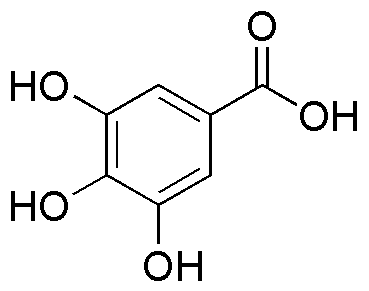Gallic acid anhydrous is widely utilized in research focused on:
- Pharmaceuticals: It is used in the development of various medications due to its antioxidant properties, which help in reducing oxidative stress in cells.
- Food Preservation: This compound acts as a natural preservative, enhancing the shelf life of food products by preventing spoilage and microbial growth.
- Cosmetics: In the beauty industry, it is incorporated into skincare products for its anti-inflammatory and skin-soothing effects, making it ideal for sensitive skin formulations.
- Analytical Chemistry: Gallic acid anhydrous serves as a standard in various analytical methods, aiding researchers in quantifying phenolic compounds in plant extracts.
- Plant Protection: It is applied in agriculture as a biopesticide, helping to protect crops from fungal infections while being environmentally friendly.
General Information
Properties
Safety and Regulations
Applications
Gallic acid anhydrous is widely utilized in research focused on:
- Pharmaceuticals: It is used in the development of various medications due to its antioxidant properties, which help in reducing oxidative stress in cells.
- Food Preservation: This compound acts as a natural preservative, enhancing the shelf life of food products by preventing spoilage and microbial growth.
- Cosmetics: In the beauty industry, it is incorporated into skincare products for its anti-inflammatory and skin-soothing effects, making it ideal for sensitive skin formulations.
- Analytical Chemistry: Gallic acid anhydrous serves as a standard in various analytical methods, aiding researchers in quantifying phenolic compounds in plant extracts.
- Plant Protection: It is applied in agriculture as a biopesticide, helping to protect crops from fungal infections while being environmentally friendly.
Documents
Safety Data Sheets (SDS)
The SDS provides comprehensive safety information on handling, storage, and disposal of the product.
Product Specification (PS)
The PS provides a comprehensive breakdown of the product’s properties, including chemical composition, physical state, purity, and storage requirements. It also details acceptable quality ranges and the product's intended applications.
Certificates of Analysis (COA)
Search for Certificates of Analysis (COA) by entering the products Lot Number. Lot and Batch Numbers can be found on a product’s label following the words ‘Lot’ or ‘Batch’.
*Catalog Number
*Lot Number
Certificates Of Origin (COO)
This COO confirms the country where the product was manufactured, and also details the materials and components used in it and whether it is derived from natural, synthetic, or other specific sources. This certificate may be required for customs, trade, and regulatory compliance.
*Catalog Number
*Lot Number
Safety Data Sheets (SDS)
The SDS provides comprehensive safety information on handling, storage, and disposal of the product.
DownloadProduct Specification (PS)
The PS provides a comprehensive breakdown of the product’s properties, including chemical composition, physical state, purity, and storage requirements. It also details acceptable quality ranges and the product's intended applications.
DownloadCertificates of Analysis (COA)
Search for Certificates of Analysis (COA) by entering the products Lot Number. Lot and Batch Numbers can be found on a product’s label following the words ‘Lot’ or ‘Batch’.
*Catalog Number
*Lot Number
Certificates Of Origin (COO)
This COO confirms the country where the product was manufactured, and also details the materials and components used in it and whether it is derived from natural, synthetic, or other specific sources. This certificate may be required for customs, trade, and regulatory compliance.


